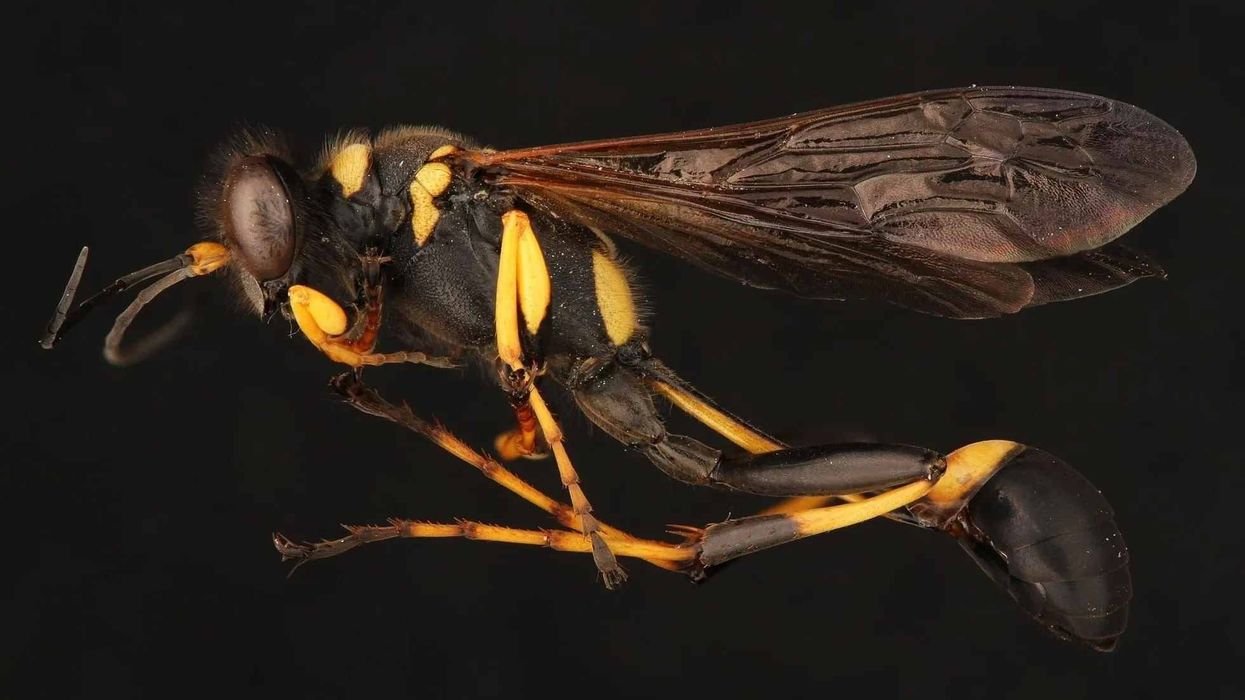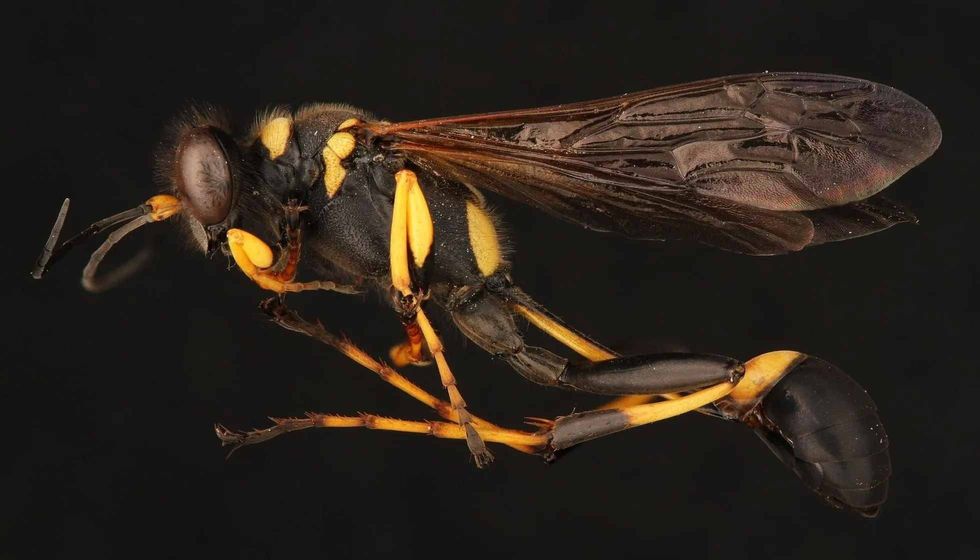Black-and-yellow mud daubers are insects who prey on spiders and are native to North America. These wasps belong to the family Sphecidae.
These wasps almost look similar to a blue mud dauber wasp and solitary wasps, with the exception of different skin color. The black-and-yellow mud dauber wasp nests are usually present near human settlements. These insects prey on spiders, even on the black widow spider, which itself is a very deadly predator.
The female black-and-yellow mud dauber wasps are responsible for building the nest and male wasps are never seen building the nests. However, the male black-and-yellow mud dauber wasps guard the nests against predators while females are busy building the best.
Black-and-yellow mud dauber venom has the ability to paralyze spiders but the venom is not lethal to humans although it can cause serious infections if someone is allergic. Here are some interesting facts on this fascinating insect of North America.
After reading these facts on the black-and-yellow mud dauber wasps, check out our other articles on the great golden digger wasp and great black wasp.
Black-And-Yellow Mud Dauber Interesting Facts
What type of animal is a black-and-yellow mud dauber?
A black-and-yellow mud dauber wasp (Sceliphron caementarium) is an insect, a wasp. You can find these intelligent mud daubers in an old house as they build their nests in man-made structures. These insects are lethal predators when it comes to spiders wherein they first kill the prey with the venom and then drag it back to the nest cell.
What class of animal does a black-and-yellow mud dauber belong to?
A black-and-yellow mud dauber or wasp (Sceliphron caementarium) belongs to the arthropod class of animals. Mud daubers belong to this largest and respectable class of the phylum. The arthropod class consists of animals like crabs, lobsters, and other insects.
How many black-and-yellow mud daubers are there in the world?
There is no exact count on how many black-and-yellow mud dauber wasps are in the world, but you could say there are millions of them. A black-and-yellow mud dauber nest can be found in many places.
Where does a black-and-yellow mud dauber live?
A black-and-yellow mud dauber or wasp (Sceliphron caementarium) lives in mud nests built-in small cracks of houses, walls, or other man-made and natural structures. The mud nest is easily identifiable. Black-and-yellow mud daubers don’t actually stay overnight in their mud nests. These wasps hide in nearby trees and bushes to keep watch on the mud nest.
What is a black-and-yellow mud dauber's habitat?
A black-and-yellow mud dauber or wasp (Sceliphron caementarium) is mostly seen near flowers consisting of nectar and near muddy lands. The female mud dauber builds mud nests only for the purpose of laying eggs.
The mud dauber nests are seen in buildings, walls, cliffs, rock ledges, and outside houses. These mud dauber wasps are always spotted near man-made or natural structures where they build their nests. This wasp species build nests where they could easily find their prey, spiders.
Who do black-and-yellow mud daubers live with?
Black-and-yellow mud daubers or, as scientifically called, Sceliphron caementarium, live on their own. This wasp species is sometimes spotted with the opposite sex of their own species.
How long does a black-and-yellow mud dauber live?
A black-and-yellow mud dauber lives for almost one year. This wasp has a short lifespan.
How do they reproduce?
Black-and-yellow mud daubers, or the wasp Sceliphron caementarium drury, reproduce sexually. The males impregnate females by putting their sperm into the females through which an egg is formed. The males usually guard the mud dauber nests while females build them to lay eggs.
There are up to 25 nest cells; built with mud. The females bring spiders and put them in each nest cell. The spiders are immobilized by the black-and-yellow mud daubers' sting.
The females lay one egg on each of the paralyzed spiders. The eggs then convert to a cocoon and then feed on the spider. After growing, the larvae bite through the nest to come out.
What is their conservation status?
The conservation status of a black-and-yellow mud dauber, Sceliphron caementarium drury, is Least Concern (LC).
Black-and-Yellow Mud Dauber Fun Facts
What do black-and-yellow mud daubers look like?
Black-and-yellow mud daubers of family Sphecidae are black and yellow in color. This wasp species has a long narrow waist called a pedicel. The pedicel is almost half the length of their abdomen.
Daubers have a pointed tip at the end used for stinging. The pointed tip of the males is straight, while that of the females is a bit curved. Their wings are of mud color.
This wasp has six legs and two bee-like antennas. Their thorax and abdomen are black in color, and the thorax has yellow spots all over it. Its sting can hurt a lot.
How cute are they?
Black-and-yellow mud daubers are quite cute. They are small, and their pointed ends stand out. Children love to watch these insects fly around. The dauber has a great resemblance to that of a spider and can be known as a dauber spider.
How do they communicate?
A black-and-yellow mud dauber uses pheromones to communicate with others of its species. Pheromones are mostly transmitted through the air but can also be conveyed through soil and water.
How big is a black-and-yellow mud dauber?
A black-and-yellow mud dauber is 0.9-1.1 in (2.3-2.7 cm) long. A female mud dauber has a height of around 0.5 in (1.3 cm). These insects are three to four times smaller than a caterpillar.
How fast can black-and-yellow mud daubers move?
A black-and-yellow mud dauber can move at a speed of around 19.8 mph (31.8 kph).
How much does a black-and-yellow mud dauber weigh?
A black-and-yellow mud dauber is a very small insect and there are no verified estimates of its weight.
What are the male and female names of the species?
There are no specific names for male and female mud daubers of black-and-yellow mud daubers species.
What would you call a baby black-and-yellow mud dauber?
A baby black-and-yellow mud dauber is called a larva.
What do they eat?
Black-and-yellow mud daubers prey on spiders. Adult daubers are known to feed on nectar, honey, and fluids of the spiders. As these mud daubers belong to the largest Arthropod class, they also feed on dangerous spiders like black widows. These daubers do not like to live in groups and are solitary in nature.
Are they harmful?
No, black-and-yellow mud daubers are not harmful to humans. They do not mediate with humans in any way. They mind their own business and rarely ever attack humans, even if someone breaks their nest. The black-and-yellow mud dauber sting is not poisonous to humans, but it can cause infection.
Would they make a good pet?
Black-and-yellow mud daubers are very tiny and, if kept in the house, can cause a nuisance. They will build nests all over the house if allowed. They can also attract other insects feeding on them and that is why they will not make a good pet.
Did you know...
Only female mud daubers build the nests.
Sometimes blue mud daubers are spotted.
An online guide to Eastern North American Sphecidae has information to identify all the mud dauber insects.
How do black-and-yellow mud daubers affect plants?
The black-and-yellow mud dauber wasps eat nectar from the flowers. The flowering plants are the ones affected by black-and-yellow mud daubers. The non-flowering plants are left alone by this species.
These insects eat a lot of nectar and hence can alter a plant’s flowering ability. They drink nectar until there's nothing left, and that is harmful to the plants. Plants like catnip, dandelion, hazel, saffron, and others are affected by black-and-yellow mud daubers.
Black-and-yellow mud daubers and humans
Black-and-yellow mud daubers hardly ever sting humans. They attack only when they are provoked due to rough handling. They do not bother humans and prey on spiders.
In a way, black-and-yellow mud daubers are beneficial to humans. Hence, it is advisable to leave them alone. But for some reason, if you want to get rid of them, you can just relocate their nest(s).
Here at Kidadl, we have carefully created lots of interesting family-friendly animal facts for everyone to discover! Learn more about some other arthropods from our black carpenter ant facts and atlas beetle facts pages.
You can even occupy yourself at home by coloring in one of our free printable bee coloring pages.









